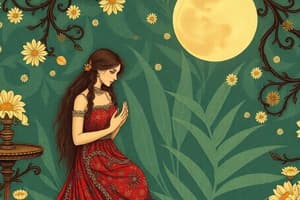Podcast
Questions and Answers
Time, place, and physical characteristics of where a story takes place.
Time, place, and physical characteristics of where a story takes place.
Setting
Assigning human qualities to an animal, object, or idea.
Assigning human qualities to an animal, object, or idea.
Personification
Force or character working against the main character.
Force or character working against the main character.
Antagonist
Contrast between what is expected to happen and what actually exists or happens.
Contrast between what is expected to happen and what actually exists or happens.
Expresses the writer's attitude toward his or her subject.
Expresses the writer's attitude toward his or her subject.
Person, animal, or creature in a literary work.
Person, animal, or creature in a literary work.
Main character, may be a hero or heroine, with whom the audience tends to identify.
Main character, may be a hero or heroine, with whom the audience tends to identify.
Comparison of two unlike things, using like or as.
Comparison of two unlike things, using like or as.
Hints to the reader as to what may happen later in the text.
Hints to the reader as to what may happen later in the text.
Descriptive language appealing to the senses.
Descriptive language appealing to the senses.
Struggle between character and outside force.
Struggle between character and outside force.
Comparison of two things that have some quality in common, without using like or as.
Comparison of two things that have some quality in common, without using like or as.
A feeling that a literary work conveys to readers.
A feeling that a literary work conveys to readers.
Language used by the author for specific effect.
Language used by the author for specific effect.
Struggle within a single character.
Struggle within a single character.
Identify point A on the chart.
Identify point A on the chart.
The second paragraph, “But one day, they quarreled...” is an example of which of the following:
The second paragraph, “But one day, they quarreled...” is an example of which of the following:
The third paragraph, “The man sat alone in his house...” is an example of which of the following:
The third paragraph, “The man sat alone in his house...” is an example of which of the following:
How are each of the following senses appealed to (quote from paragraph)? Sight:
How are each of the following senses appealed to (quote from paragraph)? Sight:
Who is the protagonist of this passage?
Who is the protagonist of this passage?
Death is an example of which of the following literary elements?
Death is an example of which of the following literary elements?
The third paragraph, “With a heavy sigh like wind through a catacomb,” is an example of which of the following:
The third paragraph, “With a heavy sigh like wind through a catacomb,” is an example of which of the following:
What is ironic about the reaction of other people to Death's absence?
What is ironic about the reaction of other people to Death's absence?
The use of synonyms, “winding, twisting, and bending” is used to create a more vivid description illustrate which element?
The use of synonyms, “winding, twisting, and bending” is used to create a more vivid description illustrate which element?
The paragraph to the left is an example of which literary element?
The paragraph to the left is an example of which literary element?
What do you learn about the setting from the passage to the left?
What do you learn about the setting from the passage to the left?
Who are the characters in the story at this point?
Who are the characters in the story at this point?
The narration in this passage becomes frantic and nervous, especially in describing the beat of the heart; the language describing the heart and the shorter sentences are used to establish what?
The narration in this passage becomes frantic and nervous, especially in describing the beat of the heart; the language describing the heart and the shorter sentences are used to establish what?
The description of the night, "And now at the dead hour of the night, amid the dreadful silence of that old house, so strange a noise as this excited me to uncontrollable terror,” establishes which literary element?
The description of the night, "And now at the dead hour of the night, amid the dreadful silence of that old house, so strange a noise as this excited me to uncontrollable terror,” establishes which literary element?
"He had the eye of a vulture—a pale blue eye, with a film over it” is an example of which literary element?
"He had the eye of a vulture—a pale blue eye, with a film over it” is an example of which literary element?
Explain the irony found in the comic to the right.
Explain the irony found in the comic to the right.
Flashcards
Setting
Setting
Time, place, and physical characteristics of where a story takes place.
Personification
Personification
Assigning human qualities to an animal, object, or idea.
Antagonist
Antagonist
Force or character working against the main character.
Irony
Irony
Signup and view all the flashcards
Tone
Tone
Signup and view all the flashcards
Character
Character
Signup and view all the flashcards
Protagonist
Protagonist
Signup and view all the flashcards
Simile
Simile
Signup and view all the flashcards
Foreshadowing
Foreshadowing
Signup and view all the flashcards
Imagery
Imagery
Signup and view all the flashcards
External Conflict
External Conflict
Signup and view all the flashcards
Metaphor
Metaphor
Signup and view all the flashcards
Mood
Mood
Signup and view all the flashcards
Word Choice
Word Choice
Signup and view all the flashcards
Internal Conflict
Internal Conflict
Signup and view all the flashcards
Imagery
Imagery
Signup and view all the flashcards
Metaphor
Metaphor
Signup and view all the flashcards
Study Notes
- Test covers literary elements and short stories
- Consists of definitions, story element identification, and passage analysis
Literary Elements Definitions
- Setting is the time, place, and physical characteristics of a story's environment
- Personification assigns human qualities to non-human entities
- Antagonist is the force or character opposing the main character
- Irony contrasts expected outcomes with reality
- Tone expresses the writer's attitude toward the subject
- Character refers to a person, animal, or creature in a literary work
- Protagonist is the main character that the audience identifies with
- Simile compares two unlike things using "like" or "as"
- Foreshadowing provides hints about future events in the text
- Imagery uses descriptive language to appeal to the senses
- External conflict involves a character's struggle against an outside force
- Metaphor compares two things without using "like" or "as"
- Mood is the feeling conveyed to readers through the literary work
- Word choice is the author's use of language for specific impact
- Internal conflict is a character's struggle within themselves
Story Elements
- A represents the exposition in the story
- B represents Character(s) in the story
- C represents the setting in the story
- D represents the rising action in the story
- E represents the climax in the story
- F is the falling action
- G is the resolution
Passage Analysis: Strawberries
- The quarrel between the first man and woman is an example of foreshadowing
- The man alone in his house exemplifies internal conflict
- Sight is appealed to by use of descriptive phrases such as “thick green carpet”, “tiny white flowers” and “berry that was the color and shape of the human heart”.
- Taste is appealed to in the phrase “taste was as sweet as love itself”
- Smell is appealed to in the phrase "delicious aroma came up through her nose"
Passage Analysis: Aunty Misery
- Aunty Misery is the protagonist
- Death embodies the antagonist
- Death represents personification
- The description, “With a heavy sigh like wind through a catacomb,” contains a simile
- The irony lies in those who benefit from death are upset by its absence.
Passage Analysis: Woman in the Snow
- The synonyms "winding, twisting, and bending" in the description illustrate word choice
- The paragraph is an example of foreshadowing, hinting at future hazardous driving conditions.
Passage Analysis: The Girl in the Lavender Dress
- The setting includes Vermont and Claremont, New Hampshire, during World War II, with limited gas and a cool, misty fall night
- The characters include Grandma, Herbert, and the girl in the lavender dress
Passage Analysis: The Tell-Tale Heart
- The narration's frantic and nervous tone helps establish Mood
- The description of the night establishes Mood
- "He had the eye of a vulture—a pale blue eye, with a film over it” is an example of Metaphor
Studying That Suits You
Use AI to generate personalized quizzes and flashcards to suit your learning preferences.




